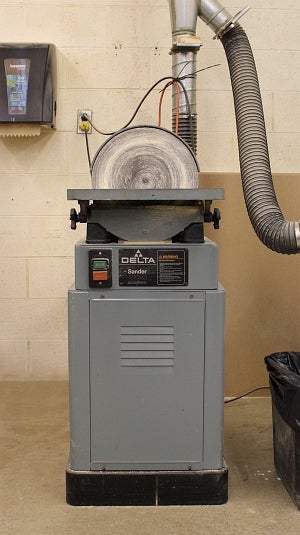Description and uses
The disc sander is useful for truing the ends of lumber. It can also be used for chamfering edges and evening up the ends of laminated materials. It is an aggressive sander in comparison to the belt sander. It has a steel bed (material rest) that sits at ninety degrees to the disc in its default position. The bed can be adjusted up to 45 degrees from perpendicular. The bed is also cut with a channel to accept a standard mitre gage, allowing you to accurately true material to common or complex compound angles.
Basic sanding
Stand in a stable position and hold your material firmly on the sander's bed with both hands. Longer pieces may need to be supported by a work support. Push the material gently into the sanding wheel, making sure to keep your hands away from the abrasive surface. Always sand on the left hand(downward) side of the disc and make sure that the material is held firmly on the bed to prevent it from kicking up.
Further considerations
- Make sure that the abrasive disc is not torn or loose.
- Never work with loose gloves or hold material with a rag when sanding
- Ensure that the bed is clear of materials, tools, and debris.
Tip
Sand slowly, periodically checking for measurements and alignme
Cautions
- Eye protection is mandatory
- Ear protection is required for prolonged use.
- A dusk mask is recommended for plywoods and particleboard and required for MDF and certain tonic woods.
- Only operators trained in the safe operation of a disc sander are allowed to use it.
- Never start the machine with the abrasive disc touching the workpiece.
- The sanding disc of this particular sander turns counter-clockwise. Always feed material into the left hand side of the disc to prevent your workpiece from kicking up; allow the direction of the disc to keep the workpiece firmly on the bed.
